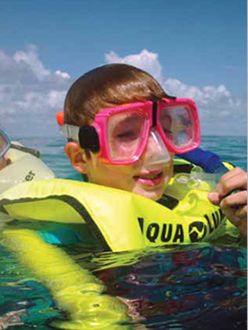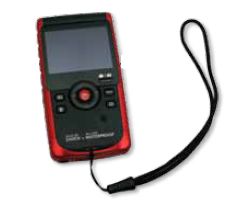
248

246
About the size of a smart phone and just a little bit chunkier, the Samsung W200 camcorder slips easily into your pocket—just right for small-boat sailing or dinghy adventures. It boasts a “shock-proof” construction and is waterproof to 9 feet. But what caught our eye was the price: $150. If it lives up to its industrial strength claims and takes some half-decent, high-def video, it’s a pretty good deal, in our book.
We tested the camera in the Florida Keys, both above the water and below and in both the camera and video modes. The camera fires up right away and is simple to operate—as it should be since it lacks all but the most basic controls. With no optical zoom, this is the epitome of a point-and-shoot.
The rechargeable battery lasts about two hours, and the memory card lets you take about 35 minutes of 1,080-dpi video. Underwater video was impressive. Photos, except those in bright sun, were flat.
Bottom line: If you are the kind who likes to have a camera ready in your back pocket while you’re on or in the water, the Samsung W200 is a handy companion. Just don’t expect too much in challenging shooting conditions.

248
In the June 2010 issue, ATN Mastclimber (formerly the Topclimber) earned kudos in our comparison of bosun’s chairs. Earlier this year, ATN introduced a revised version, one that more closely resembles climbing ascenders, the inspiration for the original Topclimber.
The Mastclimber comprises two components—foot loops and a combination waist harness/chair—each with its own ascender. By alternating between sitting in the chair and standing in the foot loops, you can inchworm your way up a pre-stretched, half-inch rope that is secured tautly from the top of the mast to the deck. With practice, a person can climb to the masthead quickly, with minimal exertion.
The ascenders on the new Mastclimber can now be fitted anywhere onto a static rope (3/8 to 5/8 inch). The original Topclimber had to be threaded onto a halyard. Other improvements include stiffer foot loops that are easier to slip your feet into and a wider backstrap on the chair harness.
We spent an afternoon testing the new Mastclimber by climbing the existing halyards on a Tartan 37. Except for those dealing with setting up, all of our previous comments regarding the original Topclimber ($300) still apply. The new Mastclimber ($430) is a well-engineered option for the solo sailor.
Three observations stood out: The new device can scratch mast paint or anodizing, and—unlike the original—can’t be easily “de-clawed” with a leather chafe guard. Also, orienting the ascenders on a static line is not obvious. We’d paint or etch an “up” arrow on each, so that it is obvious, even at night.
Bottom line: Using a dedicated climbing line adds expense and takes up stowage space, but we’d still use the new Mastclimber as we use our old one—ready to deploy with its own static line and ratchet block hoisted on a halyard. In a pinch, we can clip the new ATN to an existing halyard—a key advantage, but it also involves some trade-offs and comes with a $130 price increase.

248
While spray in the face can mean you’re having a great sail, rain in the kisser while catching some Z’s definitely rates low on the Fun-O-Meter. Good ventilation is critical to comfort belowdecks, and the V-berth hatch is a perfect conduit to channel fresh air throughout the boat. This is particularly true at anchor, where the bow typically faces into the wind.
For years, we’ve carried a wind scoop and a small canvas awning for the V-berth hatch to boost comfort belowdecks in hot weather. Both work well to let air in and to keep rain out—just not at the same time. During a recent Chesapeake Bay summer cruise, our testers had the chance to evaluate two products that aid belowdecks ventilation: The Hatch Umbrella from Sailor’s Solutions, an online retailer of innovative marine products, and the new Hatch Hoodie Awning from Banner Bay Marine, a New Jersey-based maker of cruising accessories.
The Hatch Umbrella
The Hatch Umbrella is a 3.5-foot by 3.5-foot, tent-shaped awning designed to be suspended over a hatch using a halyard and four bungee cords or pieces of line, secured to the corners. It’s constructed of a heavy-duty polyester that’s advertised as waterproof and UV protective.
Easy to set up or take down, it kept us dry during summer afternoon squalls and shaded from the mid-day sun. While it didn’t funnel wind as well as a wind scoop, it did send some breeze below and the shade it provided reduced the V-berth temperature.
Testers found the Hatch Umbrella to be fairly priced ($60), well constructed, and easy to use. Cons included the need for an available halyard, having to supply your own bungee cords, and the fact that it still represents a tradeoff between a wind scoop and rain protection.
The Hatch Hoodie
The Hatch Hoodie is an innovative solution to the scoop-versus-awning quandary. With a tensioned trapezoid shape secured at three attachment points, the Hatch Hoodie is a self-supporting awning that acts similar to a wind scoop, channeling air belowdecks.
Ventilation is maximized by a forward-facing, fiberglass-battened scoop, which can be easily adjusted for more ventilation or coverage. Using the slide stay adjustor to form a high arch directs maximum air flow belowdecks, while a flatter shape provides reduced flow and forms a low-to-the-deck awning that offers better rain protection.
The Hatch Hoodie is made of 8-ounce WeatherMax—a long-life material that we are currently testing against Sunbrella. The robustly constructed hoodie, at 6 feet by 5 feet, provides ample protection for most hatches while also generating a 26-square-foot shade zone. Like the Hatch Umbrella, the hoodie folds down small and is easy to stow.
We liked both the concept and design of the Hatch Hoodie, which provided serious ventilation belowdecks during even the rainiest days. After the initial installation and adjustments, we were able to quickly install or remove the Hatch Hoodie. (The aft stabilizing lines can be secured to stanchions or shrouds and include toggle ties that grip tight, but can be attached or released in seconds.)
Conclusion
Although considerably more expensive than the Hatch Umbrella, the Hatch Hoodie ($145) combines the protection of a hatch awning and the functionality of a low-profile wind scoop in one convenient package.
Also, its three-point attachment system provided less foredeck clutter and easier foredeck access than the umbrella (a single line to the forestay versus a spiderweb of bungees to port and starboard). One of the features testers liked most during our light-wind, afternoon shower-prone cruise was the ability to quickly adjust the hoodie to provide more breeze or more rain protection via the single forestay attachment. When wind is light, you simply slide the forestay attachment point up for a better lift angle. However, when the breeze pipes up, wind-driven rain is likely to find its way under either cover.
The $60 Hatch Umbrella is a more affordable choice for those in cooler temps seeking only sun and rain protection. And if you’re handy with a sewing machine, crafting a DIY hatch hoodie out of Sunbrella scraps from a local sailmaker would be an even cheaper—and fairly simple—approach to staying cool and dry during a V-berth siesta.




































